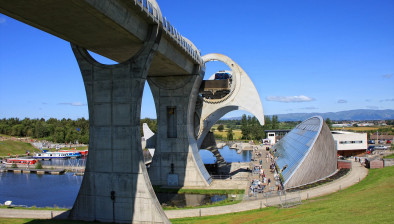Scottish Water makes progress on key Greater Glasgow infrastructure transformation

The transformation of some of Greater Glasgow’s most important infrastructure is progressing deep beneath the city streets largely out of sight of most people who live, work and travel there.
The area’s waste water infrastructure, a complex system of subterranean pipes, storage tanks and overflows on which daily life depends, is receiving a makeover.
That infrastructure has served the city well but much of it was built in Victorian times and needs to be upgraded and modernised to ensure the Glasgow area can continue to grow and flourish.
Scottish Water is now more than half way through what will be the biggest investment in the Greater Glasgow area’s waste water infrastructure in more than a century.
With work progressing every day on parts of the network across Glasgow, West Dunbartonshire, East Dunbartonshire, Renfrewshire and East Renfrewshire, an army of engineers is converting the ageing infrastructure into a modern, integrated and sustainable drainage system that will improve the environment and biodiversity on the River Clyde and its tributaries.
It will also help tackle flooding and the effects of climate change and meet the needs of growth and economic development in the city and its neighbouring areas for generations to come.
Using state-of-the-art technology and equipment that those who built the original network in the 1800s could scarcely have imagined, the investment will help ensure that some of the Glasgow area’s key underground assets are able to cope with its above-ground aspirations.
Publicly-owned Scottish Water started its £250 million, five-year programme of work to improve river water quality and the natural environment of the River Clyde in early 2013.

The investment follows years of collaboration and studies by the Metropolitan Glasgow Strategic Drainage Partnership (MGSDP), whose members include Scottish Water, the Scottish Environment Protection Agency (SEPA), Glasgow City Council and Scottish Canals.
The improvements are required to meet European directives and SEPA recommendations and will contribute towards the Scottish Government’s objective to comply with the Urban Waste Water Treatment Directive and to achieve Water Framework Directive ‘good ecological status’ or ‘good ecological potential’ for more than 40 miles of the River Clyde and its tributaries.
While Scottish Water is tackling the Greater Glasgow area’s high-priority needs in this phase of work, the MGSDP is committed to addressing all of the area’s needs and there will be further similar investment to come.
In simple terms, Scottish Water’s investment includes upgrades to about 200 Combined Sewer Overflows (CSOs) or outfall pipes – safety valves used to control waste water during heavy rainfall - on the River Clyde and tributaries such as the River Kelvin and White Cart Water at a cost of about £105m.
A total of 128 of some 222 CSOs dotted across the Greater Glasgow area have been completed.
The investment also includes a number of key projects to tackle flooding at a cost of about £45m and waste water improvements in the south west of Glasgow to remove excess surface water from areas with known “pinchpoints” which cause restrictions in the system.
The flooding investment includes completed projects such as improvements to sewer capacity in the Shettleston area of Glasgow, which has reduced the risk of flooding in Strowan Crescent, and a project to tackle flooding which has affected more than 60 properties in the Shafton Road area of Temple in Glasgow.
It also includes an ongoing £12.4m project to tackle flooding in Elmvale Row in Springburn, which started in April.
Other key flooding projects and work to improve river water quality are under way in areas such as Cathcart, Paisley, Yoker, Clydebank and Bearsden, with more in the pipeline.

The value of investment already completed is about £100m or 40 per cent of the total £250m in the five-year programme.
This includes improvements ahead of the 2014 Glasgow Commonwealth Games, such as flooding projects and overflows at Dalmarnock and Glasgow Green, which reduced the risk of problems on our network.
Geoff Aitkenhead, Scottish Water’s asset management director said: “We’re making good progress with this massive investment in Greater Glasgow’s waste water infrastructure, the biggest in living memory.
“As we speak, we are pressing ahead with many key projects simultaneously across the area.
“The environment and communities throughout Greater Glasgow will benefit hugely from this because it will protect the natural environment and meet the needs of growth, economic development and regeneration. It will also support jobs and employment opportunities, including a number of apprenticeships.
“Some major projects have already been completed and the preparatory work for others is well under way.”
At the very centre of Scottish Water’s improvements is a £100m waste water or sewer tunnel called the Shieldhall Tunnel, which will be by far the biggest single project in the programme.
The tunnel will resolve large-scale water quality problems in the River Clyde and its tributaries and provide aesthetic screening to overflows into watercourses such as tributaries of the Clyde and White Cart Water. In short, it will increase capacity and alleviate pressure on the existing network by providing additional storm water storage.
It will also reduce the risk of flooding in Aikenhead Road and Curtis Avenue in Mount Florida and Robslee Drive, Robslee Road, Robslee Crescent and Orchard Park Avenue in Giffnock.

The Shieldhall Tunnel will be constructed between Queen’s Park and Craigton industrial estate via Pollok and Bellahouston parks.
It will be built using a specially designed, state-of-the-art tunnel boring machine (TBM), which will follow a route from the Queen’s Park area towards Pollok Park.
The tunnel will head northwards under Pollok Park and beneath the M77 and then beneath Bellahouston Park, terminating at Craigton industrial estate where it will join the existing network and where waste water will flow onwards to Shieldhall Waste Water Treatment Works (WWTW), which serves up to about 585,000 people and is the biggest in Glasgow..
Some of the numbers in the Shieldhall Tunnel project are impressive. It will be 3.1 miles long - more than five times as long as the Clyde Tunnel - and 4.65m in diameter, big enough to fit a double-decker bus inside. It will be the biggest waste water tunnel in Scotland, with a storage capacity equivalent to 36 Olympic-sized swimming pools.
One of the other impressive things about the tunnel is its route, which was carefully selected to maximise the use of parkland and minimise disruption.
Most of the work will be under ground and the vast majority of people will be unaffected by the construction phase of the project.
Preparatory work, including mine working consolidation and utility diversion work, started in mid-2014.This is continuing with specialist piling work for the first shaft of the tunnel, the service chamber and the TBM launch chamber using a 60-tonne, 20 metre high crane and two 100-tonne piling rigs which, at 28 metres high, are as tall as the high-rise Jura Court flats nearby.
The team involved in the Shieldhall Tunnel for Scottish Water, known as the Glasgow Tunnel Partnership, is a commercial joint venture between Costain and VINCI Construction Grands Projets (correct) called CVJV, with additional local partners George Leslie and AECOM. Technical support is being provided by CH2M.











